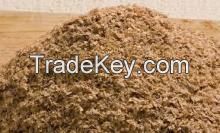Description
PKC is widely used as the main ingredient in rations for feedlot
cattle and buffaloes. In Malaysia, feedlot cattle are normally fed
up to *0% PKC with live weight gain (LWG) of 0.**0.8 kg day*1 and
*1.2 kg day*1 for local (KedahKelantan) and crossbred cattle
respectively. PKC at almost **0% has been fed to feedlot cattle
with no negative effect provided that the supply of Ca and vitamins
(in particular, A, D and E) is sufficient to meet their
requirements. Many studies have shown that supplementing the
traditional rations of beef cattle with *0%*0% PKC gave
improved
performance and increased LWG. It is a common practice in Malaysia
to produce complete feeds based on PKC, either as pellets, cubes or
total mixed ration (TMR). Apart from PKC, other common ingredients
are rice bran, brewers grain, palm oil mill effluent (POME),
tapioca waste, urea, salt and minerals (Wan Zahari et al., ***0;
***3). Carcass analysis indicated that the beef cuts were of
superior quality when compared to those for cattle fed on grass or
pasture. An example formulation for beef cattle is PKC: *0%,
grass/hay: *7.5%, limestone: 1.5% and mineral premix: 1.0%.
Owing to its high fibre content, the use of PKC in poultry rations
is very limited. There exist wide variations in the optimum
inclusion level of PKC in poultry rations. The main reasons are due
to the origin and variations in the oil and shell content of the
PKC used. Broilers can tolerate up to *0% PKC in their diets
without affecting their growth performance and feed efficiency
(Yeong, ***0). A feed conversion ratio of 1:0.*8 was reported for
broilers fed palm kernel expeller (PKE) at *5 days of age (Onifade
and Babatunde, ***9). In layer rations. PKC can be included up to
*5% without any deleterious effects on egg production and quality
(Radim et al., ***9). Inclusion of PKC at levels >*0% was
reported to reduce egg production and egg quality (Yeong et al.,
***1) but in another study, reduced egg production was observed
only at levels >*0% (Onwudike, ***8). Muscovy ducks can be fed
PKE at *0% level without any deleterious effects on their
performance (Mustafa et al., ***2). Apart from PKC, the locally
available raw materials normally used in mixing feed for poultry
are rice bran, wheat pollard, sago, tapioca and broken rice.
Examples of poultry formulations are as follows: (i) for broilers
(finisher diet): PKC: *0%, palm oil: 6%, maize: *9.8%, soyabean
meal: *5%, fish meal: 5%, lucerne leaf meal: 2%, dicalcium
phosphate: 1.5%, salt: 0.*5%, vitamin-mineral premix: 0.*0 and
DL-methionine: 0.*5%. (ii) for layers: PKC: *0%, palm oil: 2%,
maize: *5.4%, soyabean meal: *4.5%, fish meal: 7.0%, lucerne leaf
meal: *0%, dicalcium phosphate: 1.5%, limestone: 3%, oyster shell:
4.0%, vitamin-mineral premix: 0.3% and salt: 0.3% and (iii) for
meat ducks: PKC: *5%,
palm oil: 5.3%, maize: *5.1%, soyabean meal: *7.3%, fish meal: 3%,
salt: 0.*5%, dicalcium phosphate: 1.*6%, limestone: 0.*2,
DL-methionine: 0.*6% and lysine: 0.*6%.
